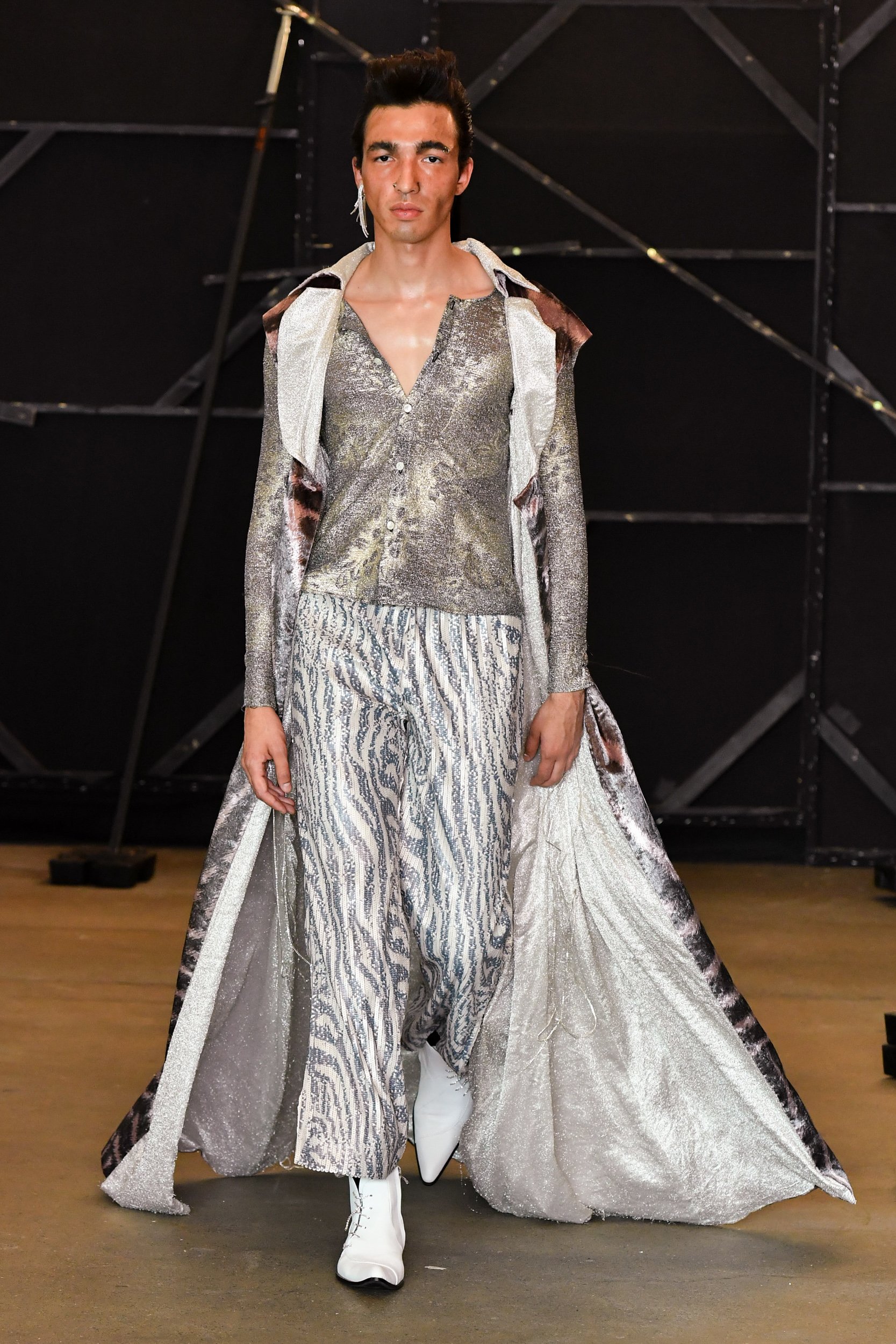Cris Miranda

Cris Miranda
CHILE
“I’m a sustainable fashion designer because I believe in the power of dressing sustainably and the needed change it represents.”
As a Latino living in Tokyo, Japan, Cris Miranda discovered the beautiful craftsmanship of the kimono and admired its deep cultural meaning and high quality fabric. The designer’s experiences in Japan made them want to share their story through their collection along with a developing manga project.
After returning to Chile, Cris became aware of environmental issues closer to home, such as the illegal clothes landfill in Atacama Desert and severe drought in the central regions. These issues led them to rethink their usual creative processes, motivating them to raise awareness of the dangers of fashion overconsumption. When a drought precipitated water rationing in their hometown of Santiago, Cris shifted from dyeing fabrics with water to textile manipulations in order to lower their environmental impact.
In their collection ‘「RE」COLLECT ’, Cris’ interaction with Japanese culture is imbued through three traditional aesthetic concepts: wabi-sabi, appreciating the beauty of the imperfect and transient; mono-no-aware, a wistfulness for impermanence; and miyabi, an elegance and refinement.
“One of the first expressions I learned in Tokyo is ‘mottainai’ — what a waste!” says Cris, who holds a BA in Fashion Design from Andrés Bello National University, Chile. To increase clothing use and lifespan, they keep sustainable aftercare in mind, equipping consumers with meticulous care instructions. In addition to laundry advice, Cris also offers to repair clothing for customers should they need mending.
Inspired by the craftsmanship, deep cultural meaning, and high quality of traditional kimono patterns and Incan clothing, the designer started learning simple zero-waste patterns and hopes to develop their skills further. The collection upcycles kimono and obi silks, locally sourced premium textile deadstock, and for a personal touch, their mother’s leather jackets.
They also designed the garments to be easily reconstructible for longevity. “Being my most intimate work to date, this collection speaks from the bottom of my heart, and for that reason, I created garments that are durable and easy to use.”
For their collection, Cris generated most of their patterns digitally, allowing them to control the exact quantity of textiles used as well as their surplus. They look forward to learning more about saving resources through digital design.
Cris plans to develop their own brand to revitalise Chile’s fashion, where surplus fabrics from the 1960s and 70s remain from a once-thriving industry.
Congratulations to Redress for successfully organising the Redress Design Award 2022.
We would like to thank all of our sponsors and partners, without whom the Redress Design Award would not be possible.
Tanja Wessels challenged herself to not buying a single item of new clothing. Read her tips on how you can do it too.
The Redress Design Award is more than just the world’s largest sustainable fashion design competition.
Dive into our photoshoot shining a new light on the future creative frontrunners.
See the stunning looks from the finalists’ collections in our first ever lookbook, professionally styled and shot in studio with Farfetch.
Discover what Redress Design Award alumni have been accomplishing recently, from fashion weeks to master’s collections, publishing research, brand collaborations, and more.
Ashutosh Panda found inspiration for his sustainable collection by looking to the stars — specifically, the magnetar, one of the most powerful neutron stars of the universe.
As a Latino living in Tokyo, Japan, Cris Miranda discovered the beautiful craftsmanship of the kimono and admired its deep cultural meaning and high quality fabric.
For designer Drina Marco, the Spanish word “monda” — meaning “fruit peel” — was the first layer to what would become her sustainable collection.
Federico Badini Confalonieri has always valued nature and the environment. When he learned of the massive issue of microplastics in fashion, he knew he had to find a way to address it.
Showcasing an ability to make something extraordinary out of the ordinary, for her collection Lívia Castro turned to a wardrobe staple: jeans.
When a transgender friend experienced cyberbullying, Nawoda Bandara decided to show solidarity through design.
Seeing fashion companies abandon their garment and fabric samples without much care raised alarms for Patrick Lam.
The collapse of Meethotamulla, a massive garbage dump, on homes in Colombo, Sri Lanka, killed over 30 people, including children — and was a turning point in the life of designer Ruwanthi Gajadeera.
Reflecting the competition’s creative legacy of revaluing waste, the editorial photoshoot of the Redress Design Award 2022 unveils a warehouse of renewed wear to showcase our finalists’ looks.
Since the approval of the EU Green Deal in 2019, the European Union has emerged as the world’s leading policy maker on sustainability issues.
After winning the Redress Design Award 2021, Jessica Chang immediately joined the Timberland design team in China, working remotely to collaborate on their upcoming Lunar New Year 2023 collection, ‘Year of the Rabbit’.
Shop or browse the latest sustainable collections from Redress Design Award alumni brands.





























